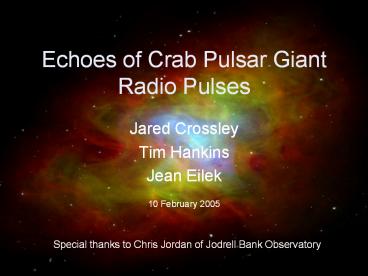Echoes of Crab Pulsar Giant Radio Pulses
Title:
Echoes of Crab Pulsar Giant Radio Pulses
Description:
Echoes of Crab Pulsar Giant Radio Pulses. Jared Crossley. Tim Hankins. Jean Eilek. Special thanks to Chris Jordan of Jodrell Bank Observatory. 10 February 2005 ... –
Number of Views:40
Avg rating:3.0/5.0
Title: Echoes of Crab Pulsar Giant Radio Pulses
1
Echoes of Crab Pulsar Giant Radio Pulses
- Jared Crossley
- Tim Hankins
- Jean Eilek
10 February 2005
Special thanks to Chris Jordan of Jodrell Bank
Observatory
2
Talk Outline
- Introduction to pulsars and the Crab
- What is known about Crab echoes
- Our new data
- Analysis
- Interpretation
- Conclusions
3
The basic model
- Rotating neutron star
- Dipolar magnetic field
- Photons emerge from the open field line region
- When the dipole moment points at us we see a pulse
4
The Crab Pulsar and Nebula
From http//chandra.harvard.edu
5
Previous Crab echo events
echo
150 days
Dickerson 2003 Backer, Wong, Valanju 2000
Pulse period (33 ms)
6
Crab echo events
Echoes events occur often at least 19 in past 20
years
Lyne, Pritchard Graham-Smith 2001
Do the new data fit the old filament model?
7
Example of giant pulse and echo
1.4 GHz, 1.5 ?s resolution
Primary
Echo
8
Echo event of 1997
1.4 GHz, 1.5 ?s resolution
9
Echo event of 1996
1.4 GHz, 500 ns resolution
10
Data Summary
- Of 38 data sets, only 2 have echoes.
- 45 of 77 pulses have clearly visible echoes at
1.4 GHz. - The other pulses had low signal to noise,
complex microstructure, and/or weak or absent
echo component - For the 1996 event
- Observations 2 days before and after show no
echoes. - No echo is visible in simultaneous 4.8 GHz data
- Further analysis was performed using fits of the
exponential scattering function
11
power
Equal power
12
width
13
toa
14
Interpretation
Our Echoes Previous Echoes
Echoes lag primary by 120 ?s 1 - 4 ms
Event lifetimes 4 days (1996) 6 - 50 days
Frequency dependence Strong (1996) weak
15
Interpretation
- Assume echoes are produced by small angle
refraction in the nebula - Note the frequency dependence
16
Refraction from wisps?
We seek a smaller pulsar-refraction distance and
a rapidly variable refracting medium One
possibility is the wisp-like region associated
with the pulsar wind shock
17
Conclusions
- Crab data from 1996 and 1997 show an echo-like
pulse component following the normal component. - This echo emission differs from other echo
emission reported previously. - It is improbable that our refraction events
occurred in the nebular filaments. We propose
refraction may be caused by the wisp-like
structures associated with the pulsar wind.































